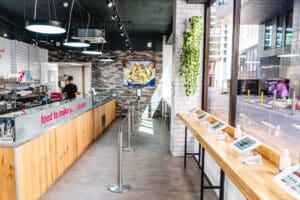The role of technology in driving efficiency
A look at technology’s role in driving efficiency for hospitality operations, and strategies you can implement today to get the most out of your tech.

Customers love to tailor their food order – but what are some other unexpected benefits to offering this service?
Having control over meal customisation is something more and more consumers expect, especially at QSR operations.
But other than giving the customer the convenience of choice, there are plenty of other major benefits to offering meal customisation. From increasing revenue to appealing to consumers concerned with sustainability, if you aren’t offering this freedom to your customers, you’re missing out.
Let’s dive into some of these overlooked benefits…
But first, a real-life example from innovative QSR salad brand Tossed – who now see 66% of all orders include some degree of customisation.
By using smart menus to deliver full personalisation of meals, Tossed have seen an 31% increased in Click & Collect order value.


Engineering your digital menus to boost profit should a central pillar of your revenue strategy, and customisation comes into play here, too.
When a consumer is adding ingredients to a dish or creating their own, this is a great opportunity to upsell and reach the maximum ATV you can from that transaction. If your menu is set up in the right way, it can inspire them to upgrade to more premium versions of ingredients, like swapping chicken thigh for chicken breast. They may also be inclined to adding extras like Halloumi cheese, further boosting that profit.
A smart menu engineering plan depends on analysis of your data – which extras are being added to what sorts of dishes? What are your more profitable ingredients you’d like to see added more often? How can you break out some of the more expensive ingredients from the base recipe of a dish and offer them as add-ons instead?
The portion sizes served at restaurants are often larger than they need to be, and while businesses are becoming more mindful of waste, it’s still a big problem.
UK restaurants collectively lose an estimated £682 million every year on food waste alone. At a time when costs are soaring and cost of living is affecting customer spend, can your business afford to see so much cost going in the bin?
One of the great benefits of meal customisation is having the ability to design each dish down to the gram. By giving customers the autonomy to order only as much as they need, it helps vastly reduce the amount of food waste from any given restaurant or food outlet.
Consumers are increasingly expecting a level of commitment to sustainability from the brands they love – especially when it comes to younger generations.
UK restaurants generate around 920,000 tonnes of food waste every year, that’s around 10% of the UK’s total food waste. It’s actively bad for the environment and a difficult number to reconcile when so many are struggling with the cost of living.
Reducing this waste by giving people the ability to control portion size is not only the right thing to do, it’s great for brand loyalty with consumers who are looking for a sustainable business.
Eating out can be a real challenge for those trying to watch their calorie intake or those suffering from allergies. It can be impossible at many restaurants to estimate how many calories are in a meal, particularly if you can’t be sure how it was cooked or exactly what ingredients were used. For example, foods cooked in oil tend to have many more calories than if they were grilled or steamed.
Consumers with allergies can also make more confident choices in their meals when they can control the ingredients used.
In this case, the benefit of meal customisation is your consumers knowing exactly what’s gone into it, and winning their trust and loyalty as a flexible place to eat.
Meal customisation benefits your customers, the planet, and your business.
Talk to one of our experts to learn how you can deliver this customisation easily, without adding complexity to the rest of your operation. Book a chat below.
Every operation has a different approach to digital. Book a chat with a restaurant tech expert below to discuss how it could look for yours.
A look at technology’s role in driving efficiency for hospitality operations, and strategies you can implement today to get the most out of your tech.


The right hospitality tech partner does more than provide software. They collaborate, innovate, and scale with your business.
